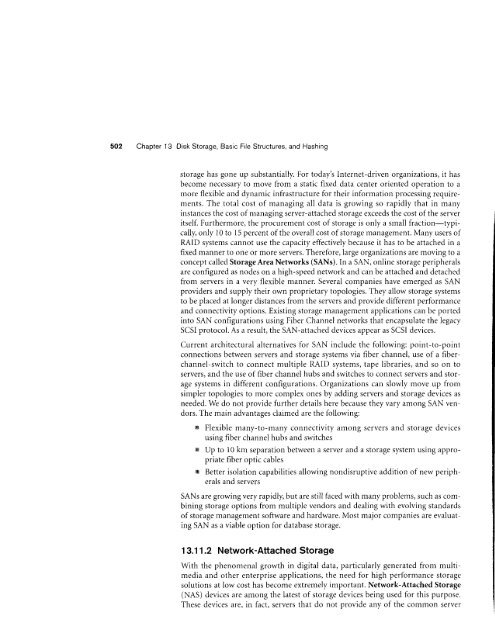13.1 through 13.5, 13.10 and 13.11
13.1 through 13.5, 13.10 and 13.11
13.1 through 13.5, 13.10 and 13.11
You also want an ePaper? Increase the reach of your titles
YUMPU automatically turns print PDFs into web optimized ePapers that Google loves.
502 Chapter 13 Disk Storage, Basic File Structures, <strong>and</strong> Hashingstorage has gone up substantially. For today's Internet-driven organizations, it hasbecome necessary to move from a static fixed data center oriented operation to amore flexible <strong>and</strong> dynamic infrastructure for their information processir-rg requirements.The total cost of managing all data is growing so rapidly that in manyinstances the cost of managing server-attached storage exceeds the cost ofthe serveritself. Furthermore, the procurement cost of storage is only a small fraction-typically,only l0 to l5 L)ercent of the overall cost of storage rnanagement. Many users ofRAID systems cannot use the capacity efTectively because it has to be attached in afixed manner to one or more servers. Therefbre, large organizations are moving to aconcept called Storage Area Networks (SANs). In a SAN, online storage peripheralsare configured as nodes on a high-speed network <strong>and</strong> can be attached <strong>and</strong> detachedfrom servers in a very flexible manner. Several companies have emerged as SANproviders <strong>and</strong> supply their own proprietary topologies. They allow storage systemsto be placed at longer distances from the servers <strong>and</strong> provide different performance<strong>and</strong> connectivity options. Existing storage management applications can be portedinto SAN configurations using Fiber Channel networks that encapsulate the legacySCSI protocol. As a result, the SAN-attached devices appear as SCSI devices.Current architectural alternatives for SAN include the following: point-to-pointconnections between servers <strong>and</strong> storage systems via fiber channel, use of a fiberchannel-switchto connect multiple RAID systems, tape libraries, <strong>and</strong> so on toservers, <strong>and</strong> the use of fiber channel hubs <strong>and</strong> switches to connect servers <strong>and</strong> storagesystems in different configurations. Organizations can slowly move up fromsimpler topologies to more complex ones by adding servers <strong>and</strong> storage devices asneeded. We do not provide further details here because they vary among SAN vendors.The main irdvantages claimed :rre the following:m Flexible many-to-many connectivity among servers <strong>and</strong> storage devicesusing fiber channel hubs <strong>and</strong> switchesm Up to l0 km separation between a server <strong>and</strong> a storage system using appropriatefiber optic cables* Better isolation capabilities allowing nondisruptive addition of new peripherals<strong>and</strong> serversSANs are growing very rapidly but are still faced with many problems, such as combiningstorage oprtions from multiple vendors <strong>and</strong> dealing with evolving st<strong>and</strong>ardsof storage management software <strong>and</strong> hardware, Most major companies are evaluatingSAN as a viable option for database storage.<strong>13.1</strong>1.2 Network-Attached StorageWith the phenomenal growth in digital data, particularly generated from multimedia<strong>and</strong> other enterprrise applications, the need for high performance storagesolutions at low cost has become extremely important. Network-Attached Storage(NAS) devices are among the latest of storage devices being used tbr this purpose.These devices are, in fact, servers that do not provide any of the comtnon server














